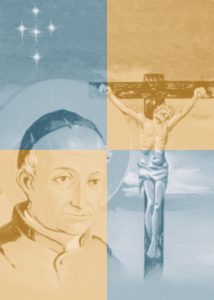St. Gaspar did not have any “experiential” knowledge of the Sacred Wounds of the Lord, as has been attributed to St. Francis of Assisi and, in the 20th century, to the Franciscan, St. Pio.
However, there were severely painful incidents in his life that profoundly affected him and his personal spirituality. It enabled him to draw more closely to the Wounds of Christ as the years went by, putting on the mind of Christ Jesus [cf. Ph 2:5, ff.]. These would be:
- the deaths of his loved ones, with whom he shared his childhood years – particularly, perhaps his 3 years old sister, Matilda;
- the separation of his mother and father;
- some apostolic fear – as his teaching catechism with the Bishop present; or his assignment to help bring wayward priests back to their mission;
- life-long extended illnesses and repeated painful lancing of leg ulcerations;
- the lack of development in the early Congregation.
Perhaps like St. Paul, St. Gaspar also experienced solidarity with Christ, and something of a type of the stigmata of the Lord, bearing faithfully the “brand-marks of Jesus” [cf. Ga 6:17; 1 Co 4:11, ff.], “the sting of the flesh”.
St. Gaspar certainly lived his “thorn” throughout his life [cf. 2 Co 12:7], constantly making up for what was lacking in the sufferings of Christ [cf. Col 1:24] for the Church of his time. We shall live with Him in the power of God [2 Co 13:4], and this is how the Stigmatine Founder made an oblation [obsequium] to God’s Mercy [cf. Rm 12:1] of his sufferings, with those of Jesus Christ.
†
St. Gaspar Bertoni: Biblical and Theological Reflections on his Devotions, the Holy Espousals and the Sacred Stigmata
This present effort presented here is only one attempt – using the very words of those who are more competent in different areas of study – to suggest some thoughts, from a variety of sources, concerning the Stigmatine Devotions, and principally, the Holy Spouses and the Sacred Stigmata.
 | St. Gaspar Bertoni: Biblical and Theological Reflections on his Devotions, the Holy Espousals and the Sacred Stigmata |
†
Stigmatine Devotions
Paluch Lecture at Mundelein Seminary on April, 2008
The devotions of St. Gaspar Bertoni are basically that to the Holy Spouses, Mary and Joseph, and their Espousals. In his earlier studies, the Stigmatine historian Father Giuseppe Stofella ordered a good explanation of the choice of his devotion for the Stigmatine community. Historical reasons may be simply that the painting of the Holy Espousals that hung over its main altar, depicting from an earlier Franciscan devotion, and that his might have inspired the Founder. It might also have been in that St. Gaspar did not have a happy home: his father abandoned the family, leaving St. Gaspar [the only surviving child of his parent’s marriage].
Whatever the reason, a good insight into the principles that motivated St. Joseph is the ‘Fiat’ of Mary to God’s Word and St. Joseph’s response to the Angel of God in the night [so beautifully developed by St. John Paul IInd, in his Exhortation Redemptoris Cussos]. This is the Patronal Feast of the Stigmatines [celebrated January 23rd].
As for the integral devotion to the Sacred Stigmata – the Sorrowful Wounds of Good Friday, and the Glorious Wounds of Easter Sunday [cf. Jn 20], sending the Apostles on showing them His Sacred Stigmata as He sent them on His Apostolic Mission. While St. Gaspar was not a ‘stigmatist’ in the formal sense, he lived the sufferings of the Merciful Lord in the deaths of his loved ones in early life; the separation of his parents; the life-long poor health that he endured, and the lack of fulfillment of some of his sublime hopes. This is the Titular Feast of the Stigmatine Congregation. It is celebrated the week of ‘Mercy Sunday’, with a special commemoration on Friday of that week.
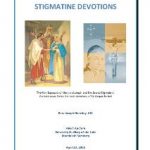 | Stigmatine Devotions [Paluch Lecture at Mundelein Seminary on April, 2008] |
†
Gaspar Bertoni: Priest of Verona, Founder of the Stigmatines. His Devotions and Service of the Church:
The Sacred Stigmata of the Lord, the Espousals of Mary and Joseph and the Sacred Heart.
Extracted from Symposium held for the Canonization of the Stigmatine Founder. October 28, 1989. Rome: Angelicum pp. 143-160.
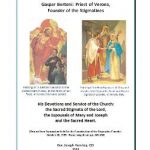 | Gaspar Bertoni: Priest of Verona, Founder of the Stigmatines. His Devotions and Service of the Church: The Sacred Stigmata of the Lord, the Espousals of Mary and Joseph and the Sacred Heart |
†
Stigmatine Devotions: the Espousals and the Stigmata in the Apocalypse
In the Stigmatine world, we often thought about our Devotions to the Sacred Stigmata both Sorrowful and Glorious – and the Espousals of Mary and Joseph as to stem from the fact that St. Gaspar Bertoni was a life-long invalid, very capable Confessor – and that he came from a broken home, his father abandoning the family unfaithfully pursuing his own personal interests.
But there is a deeper reason: in Fr. Raymond Brown’s classical treatment of the 4th Gospel, the author has presented Jon’s Book of Signs [J 1-112] as centered around liturgical festivals: the Sabbath; the Passover [Jn 5-6]; and the Feast of Ingathering, the Harvest, Tents, Tabernacles in the fall of the year [Jn 7-8]. In the spring-time, there was the Festival of Blood and the sacrificial Lamb – in the autumn of life, all returned to the Sheep-pen to hunker down during the winter rains.
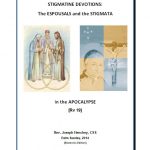 | Stigmatine Devotions: the Espousals and the Stigmata -in the Apocalypse |
†
The Sacred Stigmata: A Mystery to be Believed – A Feast to be Celebrated – A Devotion to be Lived
In one of his early Encyclicals, Sacramentum Caritatis, Pope Benedict XVI presents the Eucharist as a Mystery of Faith, a Liturgy to be celebrated and a life to be lived. By an ‘analogy of faith’, an application might be made of this formulation to the Devotion to the Five Wounds of our Lord Jesus Christ. As one of the blood ancestors of Jesus Christ in Joshua, Rahab hung out her window a prophetic scarlet sign for her future redemption.
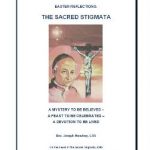 | The Sacred Stigmata: A Mystery to be Believed - A Feast to be Celebrated - A Devotion to be Lived |
†
A Few Reflections on the Feast of the Sacred Stigmata
Reflections on the four lessons from the Feast of the Sacred Stigmata – the Stigmatine title feast. Christ’s sacrifice is the supreme Gift of Mercy. The Mystery of the Sacred Stigmata opens up for us these clefts in the Rock from which the Church and her Sacraments are born; the Wound in the Side is seen to be the opening of the Tabernacle of the Most Holy Trinity.
†
The Stigmata of Jesus Christ and the Integral Liberation through Mercy. Mercy and Liberation. Redemption as Healing.
Cf. Portare Cristo all’Uomo. Congresso del Ventennio dal Concilio Vaticano IIo. Pontificia Universitá Urbaniana 1985, pp. 651-667.
 | The Stigmata of Jesus Christ and the Integral Liberation through Mercy. Mercy and Liberation, Redemption as Healing |
†
St. Gaspar’s “Integral” Stigmata: The Risen Lord
Reflections for the Solemnity of St. Gaspar Bertoni in 2018, based on a phrase from a Sermon preached by St. Gaspar Bertoni on April 5, 1807 – first Sunday after Easter: “… Look for me in the Wound of Christ’s Side…”.
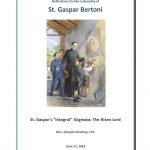 | St. Gaspar's "Integral" Stigmata: The Risen Lord - by Rev. Joseph Henchey, CSS [2018] |
†
St. Catherine of Siena: A Historical and Prophetic Synthesis of the Consecrated Life
The Espousals of Mary and Joseph, and the Sacred Stigmata of Jesus Christ, are an essential part of the spiritual heritage of St. Gaspar Bertoni.
A Lived Experience of the Espousals with Jesus Christ and His Sacred Stigmata.
Extracted from the Acts of the International Congress of Catherinian Studies. Siena – Rome: April 24 – 29, 1980. Roma: Curia Generalizia OP, 1981 [pp. 632 – 652].
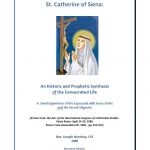 | St. Catherine of Siena: A Historical and Prophetic Synthesis of the Consecrated Life |
†
The Cross of San Damiano
With insights of St. Gaspar Bertoni
This is the Icon that much – inspired St. Francis of Assisi, inviting him to go, to repair the Church founded by Christ in His sufferings, death, resurrection and ascension – and on Pentecost. This Church is constantly in need of renewal. This Icon is an invitation to pray, beginning with the bottom of the scene, to its implication of the Ascension – noting Christ taking a step upward into the Heavenly Choir. This is a contemplation in color of the source of eternal life.
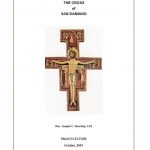 | The Cross of San Damiano [with insights of St. Gaspar Bertoni] - Paluch Lecture by Rev. Joseph Henchey, CSS [2007] |
†

